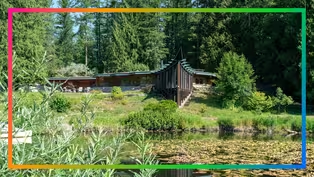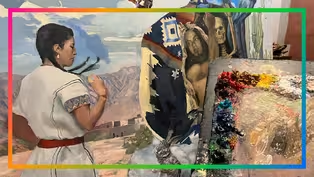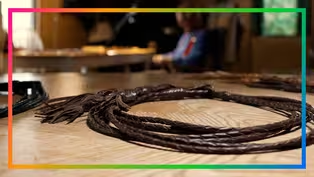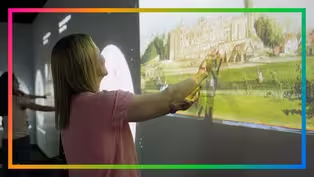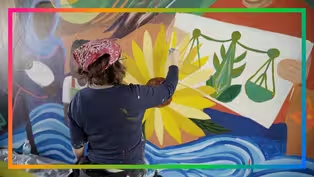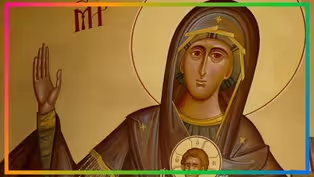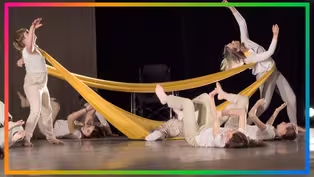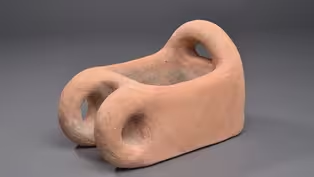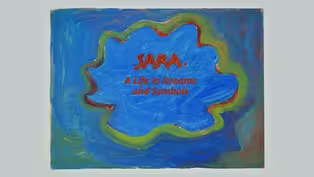
SARA: A Life in Dreams and Symbols
Season 1 Episode 8 | 30m 47sVideo has Closed Captions
An illuminating look at the life and work of Idaho artist Sara Joyce.
Delve into the life and work of Sara Joyce, a prolific artist who lived in Idaho from 1947 to her death in 2011. ‘Sara,’ as she was simply known, worked in multiple mediums, including ceramics, fiber arts and painting. Many of her works were inspired by her dreams. This is the Emmy award-winning broadcast look at her art.
Problems playing video? | Closed Captioning Feedback
Problems playing video? | Closed Captioning Feedback
createid is a local public television program presented by IdahoPTV
MAJOR FUNDING IS PROVIDED BY THE IDAHO PUBLIC TELEVISION ENDOWMENT AND THE CORPORATION FOR PUBLIC BROADCASTING.

SARA: A Life in Dreams and Symbols
Season 1 Episode 8 | 30m 47sVideo has Closed Captions
Delve into the life and work of Sara Joyce, a prolific artist who lived in Idaho from 1947 to her death in 2011. ‘Sara,’ as she was simply known, worked in multiple mediums, including ceramics, fiber arts and painting. Many of her works were inspired by her dreams. This is the Emmy award-winning broadcast look at her art.
Problems playing video? | Closed Captioning Feedback
How to Watch createid
createid is available to stream on pbs.org and the free PBS App, available on iPhone, Apple TV, Android TV, Android smartphones, Amazon Fire TV, Amazon Fire Tablet, Roku, Samsung Smart TV, and Vizio.

createid on YouTube
createid celebrates the unique talents of Idaho creators through lively video pieces. See exclusive content and join the community on Facebook, Instagram and YouTube. Subscribe now!Providing Support for PBS.org
Learn Moreabout PBS online sponsorshipMore from This Collection
createid
Video has Closed Captions
Unicorn Farm is a one-of-a-kind home in northern Idaho. (7m 50s)
Video has Closed Captions
Painter Lupe Galván melds his indigenous heritage with his love of European painting. (6m 56s)
Video has Closed Captions
Watch as Idaho leather braider Mike “Hooey” Storch crafts a traditional hat band. (5m 43s)
Video has Closed Captions
Step inside the immersive, touchscreen environment of the Stein Luminary. (4m 51s)
Video has Closed Captions
When the voices for hate get loud, the voices (and paint brushes) for love get louder. (6m 2s)
Video has Closed Captions
An ancient art form uplifts an historic Greek Orthodox Church in Pocatello, Idaho. (8m 1s)
Flipping the Script: Open Arms Dance Project
Video has Closed Captions
A profile of the Open Arms Dance Project, an inclusive, multi-generational dance company. (7m 48s)
Providing Support for PBS.org
Learn Moreabout PBS online sponsorshipVoice of Sara (Actor): I have lately experienced anxiety and fear -- terror -- over the commitment to art and to naming myself “Artist.” But when I consider the alternative of not doing, or not entering, or not naming... well, there isn't a choice.
John Caccia: My mother was a true artist.
She was expressing herself without regard for whether or not anybody would like it, whether or not it would be sold.
Margo Proksa: She was a dreamer, a powerful dreamer.
Her content is universal.
It goes beyond the borders.
Ramsay Ballew: You can't pigeonhole this artist because she just did all of it.
Roger Rowley: Sara's work with the simplest of brushstroke gestures, embodied tremendous amounts of emotional weight.
Bill Caccia: She worked in oil, she worked in acrylic.
And she was very involved in journaling.
Heidi Linehan: You know, you see her dream life in these journals.
And they're just fascinating.
Margo: There's a lot of great clay artists, but Sara was one of the greatest, in my opinion.
Bill: She had a lifelong relationship with fabric.
Roger: If you want to own a piece of art history, it’s the half bodies.
Those things are phenomenal.
They’re just -- wow.
Wow!
John: Mom had that inner passion.
She was a very passionate person.
She had a full range of emotional responses, and I think that's that comes out in her art.
Ramsay: She had a way in her work of bringing her fears close and of acknowledging them and taking away their power.
Heidi: As many times as I've looked at her paintings, as many times as we looked at the journals, I always see something else.
It’s like the first time I've ever looked at it.
Ellen Vieth: This woman is really a genius.
She's a genius.
Knowing her was like this giant, “It's okay,” you know.
You can make art.
Because you have to, you know.
And that was Sara for me.
Announcer: Major funding for createid is provided by the Idaho Public Television Endowment and The Corporation for Public Broadcasting (Music) (Sound of gas flame) John: It’s going to start to flow here pretty soon.
Yep, it flowed.
There it is.
Looks like a nice clean joint there.
It’s very satisfying to work with your hands to create something that nobody else has ever made before.
It’s just the full expression of an emotion or something inside that just needs to come out.
Narrator: Silversmith John Caccia comes by his creativity naturally.
His mother, Sara, was an accomplished artist.
Unlike her son, though, she rarely sold her work.
John: She made art just for the joy and the love of making art.
Narrator: Sara was born Joyce Marjorie Allen in 1923 in Chino, California.
And her childhood was not an easy one.
Bill: At the age of six, the Depression came on, and her family lost everything they had.
The housing was primitive.
The work was scarce.
And the food was often living on beans and corn.
The cooking, the cleaning, chopping wood, hauling water, was put on her shoulders.
Narrator: When she was only nine, Joyce experienced a deep trauma.
Bill: She was assisting her father in the delivery of her twin sisters.
And um, the smaller of the two was stillborn.
She remembers putting the baby in a shoebox and wrapping it with tissue.
That baby was named “Sarah Josephine.” Later on in life, she took the name of that stillborn sister, believing that people who die at birth live on in someone else.
Later just became “Sara.” Heidi: I think that experience that trauma, I think it lived in her always.
Narrator: When she was in her 20s, Sara met her husband, Lieutenant Italo Caccia, also known as “Babe.” In 1947, the two got married in Idaho, where Babe was a coach at a local high school.
He would go on to become the football coach and athletic director at Idaho State University.
Before long, the couple had three children.
Sara’s childhood had prepared her for motherhood, and she excelled at it.
Heidi: She was constantly making and I think it's part of growing up in the Depression where resources were very limited.
She made our clothing.
She made slip covers for the couch.
She made curtains for the wall.
John: She was a maker.
And she put that detail into her cooking and and into her relationships.
Narrator: But she didn’t always feel as if she fit in.
John: I think she felt misunderstood.
She might have been perceived as just the coach's beautiful wife, you know, and the mother of the kids.
But she also had a very serious scholastical pursuit.
Heidi: She began taking classes, all kind of classes.
Art classes.
And that was a big change for her.
She talked about being awakened intellectually when she went to university.
That was a big turning point because she then, I think, understood there are other ways to express her creativity and her originality other than what was happening in the home.
(Music) Sara began to study art, anthropology and psychology.
She was particularly drawn to the writings of Carl Jung.
Bill: I think she connected with Carl Jung because he talked about archetypal symbols and imagery that manifests themselves in a person’s psyche.
Instead of fearing those, as being able to accept them, and to be able to use that symbolism in your art.
Narrator: Soon she was energetically making all kinds of art, including ceramics.
She dug her own clay with her son, Bill, tagging along.
Bill: We would go and climb into the clay hill and dig out and look for purest clay you could find.
Because a lot of it was mixed with rock and dirt.
And Sara would build these hand forms out of that very rough clay.
Narrator: Some of her pieces incorporated Jungian archetypes.
Bill: A snake, ‘cause of its shedding of its skin, it's a regeneration and a rebirth.
And the ladder, which is one of her archetypal symbols.
Everything just always moving forward, moving upward.
Some of the others are architectural forms of houses or furniture.
The straight and the curve, which she says all art stems from.
The feminine form is portrayed in a more abstract way.
You know, just the essence of the woman.
I think that it's a sacred thing and a special part of her art.
Margo: I think some of her clay forms are very complex.
They're uncommon.
I've never seen some of these forms before, ever.
Narrator: For Margo Proksa, a Pocatello artist who was also going through a creative awakening, Sara was a kindred spirit.
Margo: I was thrilled.
I was thrilled to see some a productive, happy artist.
Her sensibilities had a lot to do with my own color, story, texture, playfulness.
It was exhilarating for me to find that soulmate.
Narrator: Sara was also painting, although that was a much more private act.
Heidi: I don't recall ever seeing her paint.
It was a very personal thing to her.
When she knew I was coming to visit, she would cover up her work.
Narrator: Many of the paintings reflected her dream life.
John: Paying attention to dreams was something that she was very dedicated to doing.
And there's a wealth of knowledge and potential that comes from our dream state.
Heidi: She would always ask every morning, “What did you dream?” Bill: She was like, much more interested in what was behind the eye than what was in front of the eye.
John: A lot of her paintings are kind of a message or a teaching.
It's more than just the mixture of colors on a piece of canvas.
Bill: You know, we all have dreams I think at some time that scare us or frighten us.
That ability to bring it out and not be afraid of it, it's a fearless thing in Sara, that I think is honest and forthright and I’m very proud of her to be able to do that.
Narrator: While Sara was growing more and more enamored with art, Babe was often on the road with the football team.
Bill: So they had two real diverse interests.
And I think those interests grew apart.
Narrator: In 1970, after nearly 25 years of marriage, the two divorced.
Bill: She was moving on with her life and doing what, you know, her calling was.
(Music) Narrator: Now single, Sara was able to support herself by using her creativity in another realm, real estate.
Bill: She did quite well with that, buying commercial buildings and Victorian homes.
On a trip to North Idaho in 1976, Sara fell in love with an abandoned storefront in the small town of Genesee.
She bought the property and turned it into a studio she would use for the next 15 years, and also purchased a home.
Voice of Sara (Actor): The house and the yard here are wonderful.
The mountains are beautiful and dramatic.
And I feel very happy to be in this area, to be in true Idaho.
Narrator: With her unique clothes and gregarious personality, Sara stood out around town.
And for one young mother, Ellen, who was also a budding artist, she was a ray of light.
Ellen: I was walking right outside this window and this woman comes out and she's wearing these garments that are like clearly handmade.
She's got an Art 21 or Artforum under her arm.
And I'm like, “What?” you know.
“Somebody else?” Because I got it to, you know.
It was a really wonderful moment for me, because I didn't feel quite so isolated knowing that somebody else here had similar interests.
Narrator: The two would spend hours together in Ellen's floral shop, moments that were preserved in Sara's journals.
Heidi: So there’s Sara and you.
This looks like Sara and I having a discussion.
These are these red clogs I wore for years.
Unlike her paintings, which were done in private, Sara's journals were accessible.
Their sketches, drawings and words provide insight into her inner and outer worlds.
Ellen: You know, she's somebody that noticed everything.
And that would all end up in her, you know, her sketchbooks, her diaries.
It didn't take a lot to inspire her, other than observation, you know?
Heidi: They're just fascinating.
She worked in every medium in the journals, from markers to uh crayon, pencil.
You can tell a dream image, because she will be laying, either on a bed or laying on a platform or just laying on the page.
Narrator: 27 journals with more than 3000 pages still exist.
They show Sara sketching ideas for what were perhaps her most extraordinary creations, her so-called “half bodies.” Deceptively simple, they're actually quite a feat to make.
Heidi: It required a lot of upper body and hand strength.
She would make these cylinder wraps.
Start with a small ball in the shape that she wanted and would wrap tight, tight, tight, tight, tight and keep on wrapping until she had the cylinder shape.
She'd do another and then it would be the round shape.
Set those on and then wrap all of them and start to shape, you know, a body.
How she was able to do that, I don't know.
This is a wrapped ball.
And this is the beginning of the process for making a half body like Marcella.
Whoa, and Marcella weighs quite a bit.
Mom has embellished her with -- this is uh, buttons on some silk thread.
You see her little heart lips, also fabric that she's very nicely stitched.
Ellen: When I first saw the half bodies that's when I was like, “This woman is really a genius.” She's a genius.
And I don't take that term lightly at all.
Narrator: Some of the half bodies are more abstract, but no less powerful.
Roger: They do in fact have kind of a featured sense to their face.
They aren't just a blob of a head.
There are features there.
Those things are phenomenal.
They’re, just, wow!
Wow!
Narrator: One half body became a constant presence in Sara's life.
She named him Lothar.
Bill: He was on a pedestal by her bed and that was her, you know, might call it her patron saint or her protector or whatever.
Uh, she felt safe with him around.
Narrator: While Sara was fascinated with form, color was absolutely essential to her process.
Voice of Sara (Actor): I usually begin a composition by brushing in a few colors.
Sometimes I add layers of color for days or weeks before a form, a figure or a pattern emerges.
The sudden emergence of a form or figure is very exciting to me and unpredictable.
Roger: Even though she was buying professional art supplies she would still use them almost like tempera paints.
So there'd be very bold greens and yellows and pinks and the kinds of things you would expect within sort of a childlike approach to painting.
And then there are other ones that the color is incredibly rich, um, and mainly in dark shades.
Bill: She thought that black was the most important color of the 20th century.
Had her own recipe for black, Phthalo Blue, Carbon Black Dioxazine Violet, and uh, Ultramarine Blue.
I think some of the dark, haunting portraits, of particularly of men that she did, were were probably, uh, archetypal imagery or her remembrance of the people they met during the Depression.
You know, they're gaunt.
They're starving.
They're destitute.
They're desperate.
Narrator: But Sara also made paintings that were more vibrant.
Heidi: These are some of my favorites.
And I guess, because they're really close to me.
And this one is uh, “Mother and Daughter,” so that's Sara and me.
She's counseling me in some way, it looks like.
And then “Dame Fortune” is you know, you never know where your fortunes might take you.
It's the unexpected.
It's wanting to participate in whatever comes your way, because you don't know what the unexpected thing is going to reveal or what you're going to experience.
And she represents that optimism, that quality that you don't know what life is going to bring.
(Music) Narrator: In 1993, after more than 15 years away, Sara moved back to Pocatello.
By then, she had a large body of work.
Her friend Margo was astonished she wasn't better known.
Margo: Nobody was keeping track of this woman.
Nobody was paying attention to her output.
I just wanted her to be known and to be seen and to be appreciated.
Narrator: Margo mounted a small show of Sara's pieces.
But Sara wasn't sold on the idea of marketing her art.
Bill: Sara wasn't really worried or interested about marketing or selling the work.
She just wanted to do it.
Heidi: If you went to her house and said, you know, “I saw this work.
I'm really interested in it.” Then mom might trade.
Mom might give.
Mom might sell, you know, for something.
But it was her own special time.
Roger: Galleries, particularly in Sun Valley and elsewhere, approached her about having shows, about representing her.
And she would be positive, but then never follow through.
She’d say, “It’s .
.
.
it’s imperfect.
It's not right.” Narrator: But she never stopped creating.
Voice of Sara (Actor): My painting is going well, and it is quite hard work, if how I feel at the end of the day is indication of it.
I am usually exhausted by evening, wondering how I am so tired when I am enjoying myself so much.
Narrator: In 2009, at age 86, Sara was becoming frail.
She moved to Moscow, Idaho, to be near Heidi, her daughter.
During the move, her children were stunned at what they found.
Heidi: We uncovered three boxes of acrylic on paper.
So I think there were, what, 150 maybe, works of acrylic on paper?
Mom’s sitting there and we go, “Mom, when did you do these?
Tell us about this.” And she just laughed and thought it was so much fun that we were just discovering those, even though they'd been right there the whole time.
Narrator: Some of the found works were included in the last exhibit of Sara's art during her lifetime, curated by her longtime friend Ellen.
Ellen: I think her work needed to be seen publicly.
It was really a beautiful show.
Margo: That was one of the highlights of my life.
I don't cry very easily, but wheeling her into that show, it just, it was, it was very powerful.
Heidi: It was hard.
But on the other hand, it was absolutely incredible to watch her just sitting in her chair and looking at everything and realizing that this was her body of work.
Ellen: She sent me a beautiful thank you note after the show.
It says, “Dear Ellen, I can't thank you enough.
All my words seem inadequate to describe what I think and feel for you.
And I never expected such a total satisfactory ending to the complete ending to this part of my life.
And I thank you and I love you.
Sara Joyce.” Yeah, it’s good, huh?
Heidi: It’s a great one.
Ellen: Yeah.
Yeah.
Narrator: Sara Joyce died on January 8th, 2011.
And today, Ellen has her own studio in Genesee in the same building where Sara used to create.
Ellen: You know, It was kind of like this complete circle.
That's where I started.
And now this is probably where in some ways I'm ending my career here in the arts.
It was kind of a miracle that it happened that way.
(Music) Narrator: After Sara's death, her family needed to figure out what to do with more than 300 pieces of her art.
The first step was just understanding what they had, because Sara hadn't named or explained much of her work.
Bill: Oh my gosh!
It's just every page has something.
Narrator: Her son, Bill, looked for answers in the thousands of pages of his mother's journals.
This is the “Thin Long Ancestral Arm,” the painting.
And then up above it, “The Little Imp Who Sees It All.” We've learned a tremendous amount through the journals and been able to give titles to almost all the pieces now.
Narrator: The effort took more than five years, culminating in a large retrospective of Sara's work at the Holter Museum in Helena, Montana.
The title, “Am I Dreaming it or Is It Dreaming Me?” was taken from one of Sara's journals.
Ramsay: I think it speaks to the work, um, in terms of questioning, like, our very reality, and what we're doing here and whether it matters or not.
Like talking about the line between the dream world and the physical world and how we occupy both simultaneously and daily.
We were able to install so much here and really take our time with it.
It was Sara-led.
She had ideas of how she would pair pieces and which pieces she wanted to live together.
We paired ceramics with the fabrics a lot, and then moved those around until they found their home with a painting.
It all kind of loops around on each other, like it all informs each other and you don't really know where to start.
So you just sort of like grab the tail of something and then go for a ride.
It's been exciting, and she has such amazing work.
I feel really lucky to have been a part of it.
Bill: What an honor it is to share our mother's art and story at the Holter.
It's been just an incredible, incredible experience for us.
I'm just going to do a little tour of the work in here, because it encompasses a lot of Sara's varieties and styles.
There are three paintings there that talk about fertility, grace and elegance.
Three of Sara's archetypal images of the feminine psyche to which she was very, very involved with.
This painting that was also discovered in her journal writings is called “Erase.” And we never did understand, “Erase,” what is that referring to?
And then in her journals, she writes, “Erase the pain and suffering, the pattern of war.” It’s talking about the social issues that, you know, she was just thinking about.
And then the Chocolate Buddha, which is another of my favorites, because of the impasto, the layering of paint.
You can get up and see just little clumps of paint in different places.
To me, it has a very positive and upbeat and happy vibe to it.
Narrator: For Sara's grandson, Wyatt, the exhibit is a chance to reconnect with the woman he's admired since he was a child.
Wyatt Caccia: This is the crown jewel of my tattoo that was inspired by her.
I see this as a woman and that her arms are the paddles.
I think gives it just a ton, a real surreal element that I really appreciated.
So there she is.
“Night Sea Crossing,” right up top.
There's no ego.
There's no, like, “I am creating this.” She was just in the stream of this.
All this was flowing through her.
It wasn't directed by her.
So it was like, “Am I the master of this?
Am I the one creating this or am I just the outlet of it?” Like, “Am I dreaming it, or is it dreaming me?” Ramsay: She wasn't creating for the pat on the back.
She wasn't creating for the acknowledgment.
She was creating because it was important that she answer the questions that she was asking, or at least ask the questions that she was asking.
Heidi: It's overwhelmingly exceptional.
And it's hard to know where to start your eyes and stop your eyes, because I want to take it all in.
I think she would be so pleased.
And so happy.
And also overwhelmed.
At last, Sara is seen as the artist and person that she truly was.
Narrator: The family still isn't sure what they'll do with all of Sara's work.
Some pieces will likely be sold, and others donated.
Part of the challenge is how to categorize Sara's style, because she worked in so many mediums and was mostly self-taught.
Roger: I think the work of Sara falls into an art category that is complicated and difficult to specifically place, because if you put it in with outsider art, naive art, you're then undermining how studied she was and how intentional she was.
That naivete was was intentional.
It was very purposeful in what she was doing.
You know, you get the parent comes saying, “My five-year-old could do that.” Then I'd say, “Well, you better get your five-year- old doing that, because, and build on that.
Because if they can do that, you've got, you've got something.” And Sara had it.
Sandra Stoops: I'm here to introduce you to an artist who is no longer living.
She was an Idaho artist.
Narrator: Meanwhile, art educators have started teaching about Sara.
Sandra: She's very special, because she does a variety of things in art.
And you know what?
She did this at a time when nobody around her was doing these things.
Her name is Sara.
Can you say “Sara?” Kids: Sara.
Sandra: Sara, Sara Joyce.
Bill: I think that's one of the things that Sara would be really tickled about.
That kids had a chance to be unabashed in exploring works created from their own experiences and their own dreams.
And maybe they're learning about their own archetypal symbols and visions.
Narrator: As much as the family has learned about Sara, some parts of her life will always be a mystery.
Her son John sees that mystery in one of her paintings, “Viola.” John: The hair coming out was really intriguing.
Like, what is that about, you know?
I could see a lot of trauma maybe that Viola was representing.
As I started looking at Viola and trying to imagine more, trying to go a little deeper into, “Why is, why is that this way?
Why aren’t there any features on her face?” I started asking myself questions and then I started putting them into the song.
Yeah.
“Viola, Viola, with your wavy winged hair, you run like the wind and fly through the air.
Viola, why do you wear a painted mask?
Are you running from the future or hiding from your past?
Viola mi amor, the world awaits to greet ya, and meet you and your creator, a artista known as Sara.” Margo: I just knew somehow, some day, the story of Sara would unfold.
And here we are.
When you find a truly unique artist, that's a real blessing.
John: Whoa!
(Music) Announcer: Major funding for createid is provided by the Idaho Public Television Endowment and the Corporation for Public Broadcasting.
Introduction to "SARA: A Life in Dreams and Symbols"
Video has Closed Captions
Clip: S1 Ep8 | 2m 23s | An illuminating look at the life and work of Idaho artist Sara Joyce. (2m 23s)
Preview of "SARA: A Life in Dreams and Symbols"
Preview: S1 Ep8 | 30s | An illuminating look at the life and work of Idaho artist Sara Joyce. (30s)
Providing Support for PBS.org
Learn Moreabout PBS online sponsorshipSupport for PBS provided by:
createid is a local public television program presented by IdahoPTV
MAJOR FUNDING IS PROVIDED BY THE IDAHO PUBLIC TELEVISION ENDOWMENT AND THE CORPORATION FOR PUBLIC BROADCASTING.
